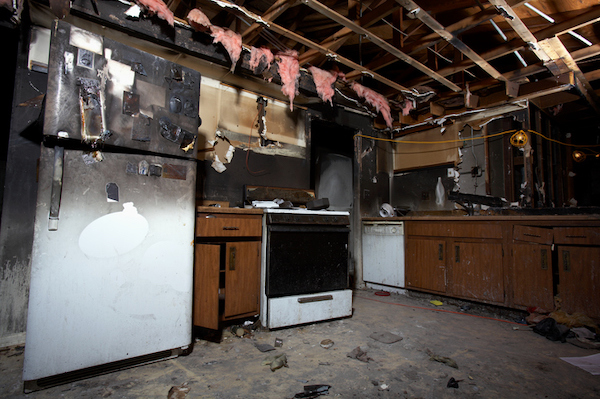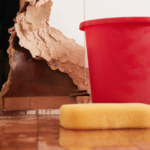Here’s a countdown of our top five:
No. 5: The House With Extreme Fire Damage
In 2021, local fire departments across the U.S. responded to roughly 1.35 million fires, according to the National Fire Protection Association. The estimated property damage from these fires cost around $15.9 billion. Roughly 25% of these fires occurred in houses, including multifamily homes.
What causes these home fires?
Most of the time, it’s caused by:
• Cooking
• Heating
• Electrical
• Smoking
• Candles
Throughout the years, we’ve purchased many houses with fire damage. There have been a few instances where people have called for a quote. They report that there was a small kitchen fire. When we visited the house to assess it, the fire damage turned out to be worse than expected — and the roof collapsed.
No. 4: The House With the Tree in the Living Room
Indoor greenery can have a therapeutic effect, making you feel calmer and more serene. Designers and architects also say it can even help boost productivity.
However, one house pushed those benefits to the limit with a giant tree root in the living room.
It happened by accident. They had a crawl space that wasn’t closed off completely.
The oversized root broke right through the opening.
No. 3: The House With the Shower in the Kitchen
Every day, roughly two-thirds of Americans take a shower. For many, it’s a routine part of the day. It helps people feel more alert in the morning or feel cleaner after a workout.
Showers also use less water than a bath, which can save you money and help the environment.
People love showers, but some love them even more than others.
In fact, one person installed a shower in their kitchen to make it more convenient to hop right in.
They cook a lot and just wanted an easy way to rinse off afterward. Multitasking at its best.
No. 2: The House With the Full-Sized Trampoline in the Bedroom
Trampolines help to build strength, bone density, improve balance, and provide stress relief, reported the Cleveland Clinic.
They’re also great for exercise, which is why — most of the time — you find them in the backyard.
But not this time.
We once purchased a house with a full-sized trampoline in the bedroom. The trampoline was used as a bed. We didn’t test it out, but we imagine it was comfortable.
No. 1: The House With 50 Cats
Nearly 31.8 million U.S. households own cats.
The average number of cats per household is 1.8, per the American Veterinary Medical Association.
One person we purchased a house from owned 50 cats.
When the inspector left the home, he said the smell stayed with him.
From a distance, the home’s crevasses looked caked in dirt.
Upon closer look, it was actually a bug infestation.
Selling a Distressed House
In all of these instances, Meridian Trust was able to help the homeowner and purchase the home. Nothing scares us.
We’ve also purchased distressed houses with:
- Extensive mold, which can grow wherever it’s wet, such as bathrooms, attics, basements, walls, or rooms with high humidity.
- Code violations, including overloaded electric panels, add-on rooms or new sections of the house, or a bathroom or kitchen remodel.
- Condemned houses, which can happen when the home has an extended vacancy, continuously disconnected utilities, hazards that make the living condition unsafe, or unpaid taxes, for example.
Contracts are rarely canceled because the home was too distressed. Houses can usually be fixed, repaired, or, if necessary, gutted.
Best of all, we purchase houses “as is” in Florida, Georgia, and Alabama.
That means, if we’re able to make you an offer, you don’t have to make any repairs to the house to sell it.
Some of the most common real estate damage we’ve seen by state include:
- Florida — Roof or water damage due to storms or hurricanes.
- Georgia — Foundation damage, due to a property built on an incline (hill).
- Alabama — Tenant damage (such as ripping holes in the walls) or absentee owners leaving the air conditioner off for an extended period of time, resulting in mold or mildew.
When you sell your house to Meridian Trust, you don’t have to make any repairs yourself or hire a contractor. You simply get paid in cash for selling your property — and we take care of the rest. It’s no longer your burden to carry.
To provide you with the most accurate quote, however, it helps us to know the extent of the home’s damage up-front. That way, when we stop by to assess the property and take pictures, everyone is on the same page about the property’s condition, and we can uphold the price we quoted.
Selling a House in a Distressed Situation
Outside of distressed houses, people sometimes face distressed situations that make them want to sell their property quickly. For example, there may have been a death in the family and someone inherited the home — or at least they thought they did. Then, out of nowhere, another heir comes out of the woodwork and contests it. We have an attorney and an in-house title agency who can help us work through any issues.
Throughout the years, we’ve also seen heated disputes between landlords and tenants. Some of it has led to tenant damage, including graffiti. We also once met a tenant who refused to let anyone mow the property’s lawn because the landlord didn’t fix the dishwasher. The grass grew all the way up to chest height. The city slapped on a code enforcement violation.
Situations like these may start like a tenant horror story, but — often— it’s just a person who feels like they’ve been wronged and wants to continue to have a roof over their head.
Meridian Trust acts as the third-party voice of relief. We listen to the underlying problems both sides are facing without taking any sides. And we come up with a solution that works for everyone.
For example, maybe the landlord wants to sell the house because the tenant is breaking the terms of their lease arrangement and is fed up. We reach out to the tenant and say, “If we purchase this house and fix the dishwasher, would you like to stay, and you can pay a new landlord?”
We never assume that anything the tenant or landlord has done is wrong or right. Sometimes, distressing situations push people past their limit. And if we can buy the house from the landlord who doesn’t want to be a landlord and allow the tenant to still live there, it’s a win-win for everyone.
It’s all about taking the time to actively listen, understand the problem, and offer a creative solution. When we do that, it allows people to turn the page on what may have been a horror story at first — and start a new, happier chapter in their lives.








